Most bone and joint diseases such as shin pain are not life-threatening, but if not treated effectively, many people can become paralyzed and disabled for life.

Shin pain can be a normal symptom when we are injured or strongly impacted by traffic accidents, work accidents, sports accidents...
However, this can also be an early warning sign of many dangerous diseases such as osteoporosis, herniated disc in the lower back and knee arthritis. These diseases all need to be examined and treated promptly to avoid possible dangerous complications.
Most bone and joint diseases are not life-threatening. However, they directly affect daily activities, health and work. If not treated effectively, many people may be paralyzed and disabled for life.
The tibia is also known as the tibia, the tibia. People with shin pain often feel pain in the bone, affecting their daily life. This condition occurs due to the following main causes.
Growing teens often experience leg pain. This is considered a normal sign because bones and cartilage grow rapidly while muscles have not yet developed to keep up.
Excessive exercise or not warming up properly before exercise can cause muscle and bone pain, especially in the shin bones.
People who carry heavy objects, work too hard, stand for long periods of time, or walk a lot cause their musculoskeletal system to be overloaded, leading to aches and pains.
People with certain diseases such as myositis, osteomyelitis, shin bone cancer, varicose veins in the legs, etc. should experience pain in the shins, especially when the patient moves.
Some external injuries or strong impacts can damage bones and joints, leading to pain.
Vitamin D and calcium deficiency in pregnant and postpartum women can also cause pain in the shin bone.
In each person, symptoms of shin pain can be different, depending on the cause and extent of damage, but it will have the following typical signs.
The shin bone area feels uncomfortable and painful, especially when walking. The pain is accompanied by burning, redness, swelling, or bruising in this area.
The shin bone is no longer flexible but becomes “stiff” due to stiffness. It will be very difficult for you to move or move as you wish.
Pain can occur in one or both legs, greatly affecting daily activities, and may be accompanied by fever if the cause is an infection.

Determining the cause and severity of shin pain will help your doctor determine the appropriate treatment plan.
If the pain is caused by overwork or overexertion, you should rest properly to reduce pressure on the shin bone area, helping the bone to recover naturally.
If the pain is accompanied by swelling or bruising, you can apply hot or cold compresses to relieve pain and reduce swelling.
If you have severe pain and signs of inflammation, your doctor will prescribe painkillers and anti-inflammatory drugs. You should take the medication at the recommended dosage to ensure effectiveness and avoid side effects.
Physical therapy is also an effective treatment method, not only to reduce pain but also to increase the flexibility of the shin bone. These exercises will be guided by a technician first, then you can do them yourself at home.
Use anti-inflammatory drugs and antibiotics in cases of shin pain caused by periostitis or compartment pain syndrome with infection. The full course of medication should be used to prevent the body from developing resistance to the medication.
Surgery if the shin bone is severely painful, and muscle tissue and ligaments are severely damaged (inflamed).
To avoid pain in your shin bones, you need to keep in mind the following things in your daily life.
You should have a reasonable amount of activity and rest to relax your leg muscles and shin bones. Avoid overworking or carrying heavy objects to limit pain.
You should exercise regularly. You need to warm up thoroughly before exercising or playing sports to avoid muscle strain, muscle strain, dislocation, sprain, etc. Choose sports that are within your strength to practice, and you should practice regularly to get your bones and joints used to movement.
Supplement with adequate nutrients, especially vitamin D (found in mushrooms, cheese, fish, eggs, etc.); protein (found in eggs, milk, seafood, cauliflower, dates, bananas, etc.) and minerals such as calcium (found in seafood, tofu, cereals, nuts, milk and dairy products, etc.); iron (found in spinach, beets, watermelon, chicken, animal liver, etc.); magnesium (found in rice, wheat, oats, almonds, cashews, dried herbs, cocoa powder, dark chocolate, etc.) to strengthen bone and joint health.
You should limit alcohol and stimulants and quit smoking.
If you experience persistent and increasingly severe shin pain, you should see an orthopedic specialist for an accurate diagnosis and effective treatment.
TB (according to Vietnam+)